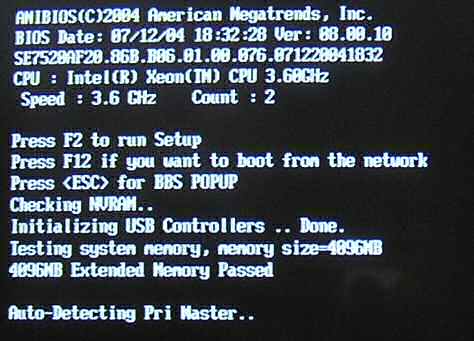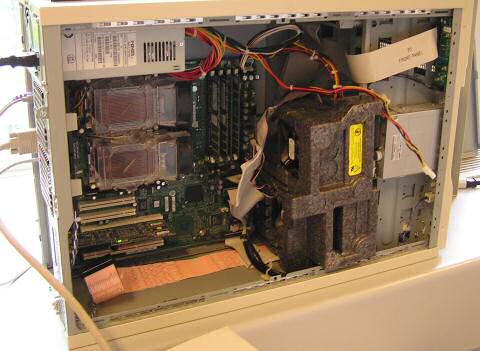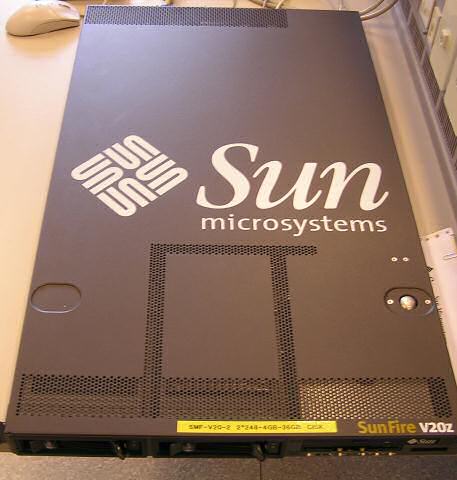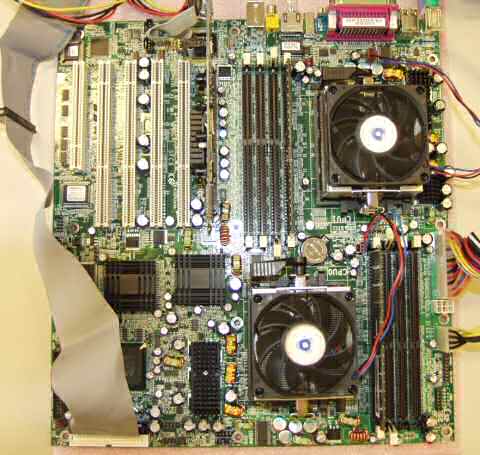Dual CPU Database Server Comparison
by Johan De Gelas on December 2, 2004 12:11 AM EST- Posted in
- IT Computing
Benchmark Configuration
To ensure that our databases work stably and reliably, we followed the guidelines of SUSE and IBM. For example, DB2 is only certified to run on the SLES versions of SUSE Linux; you cannot run it on any Linux distribution. We also used the MySQL version (3.23.52) that came with the SUSE SLES8 CD's, which was certified to work on our OS.Software
IBM DB2 Enterprise Server Edition 8.1.3 (DB2ESE), 32 bit and 64 bitMySQL 3.23.52, 32 bit and 64 bit
SUSE SLES 8 (SUSE Entreprise Edition) SP3, Linux kernel 2.4.21, 32 bit and 64 bit
Hardware
We'll discuss the different tested servers in more detail below. Here is the list of the different configurations:Intel Server 1: Dual Intel Nocona 3.6 GHz 1 MB L2-cache, 800 MHz FSB - Lindenhurst Chipset
Intel® Server Board SE7520AF2
2 GB (4x512 MB) Micron Registered DDR-II PC2-3200R, 400 MHz CAS 3, ECC enabled
NIC: Dual Intel® PRO/1000 Server NIC (Intel® 82546GB controller)

Intel Server 2: Dual Xeon DP 3.06 GHz 1 MB L3-cache, Dual Xeon 3.2 GHz 2MB L3-cache, Dual Xeon 3.2 GHz
Intel SE7505VB2 board - Dual DDR266
2 GB (4x512 MB) Crucial PC2100R - 250033R, 266 MHz CAS 2.5 (2.5-3-3-6)
NIC: 1 Gb Intel RC82540EM - Intel E1000 driver.

Opteron Server 1: SUN V20z Dual AMD Opteron 248 (2.2 GHz)
Newisys Khepri based board
2 GB: 4x512 MB Infineon PC2700R - 250033R (2.5-3-3-6)
OR 2 GB: 4x512 MB Mushkin PC3200R-232 (2-3-2-6)
NIC: Broadcom 5703, bcm5700 driver

Opteron Server 2: HP DL-145
HP motherboard
2 GB: 4x512 MB Infineon PC2700R - 250033R (2.5-3-3-6)
or 2 GB: 4x512 MB Mushkin PC3200R-232 (2-3-2-6)
NIC: Broadcom 5703, bcm5700 driver
Opteron Server 3: Tyan Thunder K8W (S2885) based
Tyan K8W S2885
2 GB: 4x512 MB Infineon PC2700R - 250033R (2.5-3-3-6)
or 2 GB: 4x 12 MB Mushkin PC3200R-232 (2-3-2-6)
NIC: Broadcom 5703, bcm5700 driver

Opteron Server 4: HP DL-585
HP custom designed motherboard
4 GB: 8x512 MB Infineon PC2700R - 250033R (2.5-3-3-6)
NIC: Broadcom 5703, bcm5700 driver

Opteron Server 5: AMD Quartet: Dual 844, Dual 848, Quad 844 and Quad 848
Quartet motherboard, Zildjian personality board, Tobias backplane board and Rivera power distribution board.
Quad configurations: 4 GB: 8x512 MB infineon PC2700 Registered, ECC enabled
Dual configurations: 2 GB: 4x512 MB infineon PC2700 Registered, ECC enabled
NIC: Broadcom NetExtreme Gigabit
Client Configuration 1: 1x Pentium 4 3.06 GHz HT on - 533 MHz FSB
MSI GNB MAX FISR (E7205)
2x512 MB Crucial PC2100R - 250033R (2-2-2-6)
NIC: 1 GB Intel RC82546EB - Intel E1000 driver
Shared Components
1 Seagate Cheetah 36 GB - 15000 rpm - 320 MB/s
Maxtor 120 GB DiamondMax Plus 9 (7200 RPM, ATA-100/133, 8 MB cache)










46 Comments
View All Comments
Decoder - Friday, December 3, 2004 - link
davesbeer: "MS is a joke".You don't know jack about enterprise IT. Mostly of the financial services industry (FSI) companies run on both UNIX and Windows. Some FSI companies have standardized on .NET and SQL Server. I know this because i work in this industry. MS is no joke. MS.NET is no joke and i can assure you MS SQL Server 2005 is no joke. $ for $, MS products deliver more value and ease of use/development/admin then anything else out there. x86-64 will help MS win over some of the 64-bit enterprise computing deals as well. MS is in the best position ever.
davesbeer - Friday, December 3, 2004 - link
I had great faith in Anandtech... until this article... not the hardware aspect but the software aspect...I never see MySql in competition... MS is a joke... known for cheap but not reliable or scalable.. DB2 is the only competition to Oracle but it is not the same database on differing platforms therefor has huge problems for customers.. Only Oracle allows you to move from one platform to another with minimal changes... Oracle is the leader in the DB market.. Gartner includes NON relational database in IBM's numbers which inflates them. Oracle commands about 70% in the Unix space and quite frankly is retaking significant ground in the Windows space with the low cost SE1 DB options.. Interesting to note that IBM benches its hardware with Oracle and not DB2..... The only thing software correct was the fact that Linux is extremely important to all the vendors and becoming more important to corporations...
Puppetman - Friday, December 3, 2004 - link
#32 - Oracle prohibits you from posting benchmarks in their licensing agreement that you have to sign to get a copy of the software, I believe.I guess this is partly because it's so complicated to set up (MySQL is easier, but tuning is still an issue).
I would have liked to have seen Postgres 7 and 8 tested. PostgresQL has the features of Oracle, and 8.0 has some pretty impressive performance numbers (the optimizer seems to be much better than the 7.4 optimizer, in my limited tests).
David
Puppetman - Friday, December 3, 2004 - link
They used a 32-bit version of MySQL 3.23, when a 64-bit version of 4.0 or 4.1 are available.No statement as to the storage engine used in MySQL (ISAM, MyISAM, InnoDB, BDB, etc), but all the big sites using MySQL (Google, Yahoo, etc) use the InnoDB engine, as it provides ACID transactions, tablespaces, foreign keys, etc.
These tests are like testing a Pentium 4 3.4ghz EE CPU with Windows 98.
mbhame - Friday, December 3, 2004 - link
Would've been nice to see some Oracle and SQL Server benches!lindy - Friday, December 3, 2004 - link
Our people soft environment consists of a application/web server running on Windows 2000 up front, with a SUN UNIX server running Oracle on the back end. In Nov-Dec the database server is busy…review/pay raise time of the year. The rest of the year it hums along.We have mostly two tier applications, WEB or Application up front on a server, database in the back on a server. However lots of turn key solutions like our Crystal Reports server and our Remedy server are an application on top of MS SQL….so essentially database servers.
Exchange is a beast, every user hits our single Exchange 2003 server….1600+ users with a total 300+ gigs of email. You are right it’s basically a database server with the Exchange application sitting on top of it…..there is no way to separate it. Exchange 2003 would be a great test for you as there are lots of load simulators for it out there that can simulate many users pounding it.
Why use a NAS when you have a SAN? Our 2 big Windows storage server 2003 file servers use a SAN for their 2 terabytes of data. These servers are backed up over fiber to a tape silo attached to the SAN. It’s about the fastest backup solution out there today. To your point the data on those file servers are slowly moving to a sharepoint solution which is a WEB server up front, and a big MS SQL database in the back….a pretty big paradigm shift.
Anyhow good article, and happy holidays!!!
tygrus - Friday, December 3, 2004 - link
What was the MySQL scalling like with the Opterons?Other OS's, other DBMS, MS Server 2003, MS SQL ?
Nocona ?
4-way intel vs 4-way AMD ?
While it's nice to isolate the CPU performance, I would like to see some more variety and real life tests for the next edition. Part of a DB server is the IO handling and disk sub-system. Try to set them up with same (best) SCSI drives (SCSI RAID card ? on-board, OEM best or after market?). A few more serach, report, maintenance and data mining tasks would be nice. Capacity and expansion options (and cost) for more disks and backup.
The other thing is that less CPU % usage for a given workload will reduce latency for potentially greater productivity. You don't want a DB server running at >50% for most of the time for speed, reliability, transaction growth, DB growth, emergency capacity. If it was <50% then failure of a CPU or it's associated memory (for Opterons) then the server ccould be run without it. I'm not saying that the system would be limited by disk IO to have that CPU <50% but that the system as a whole would be running at half its peek.
Scali - Friday, December 3, 2004 - link
This is nice, but I still miss a few configurations that I would be interested in... For starters, Xeons running in 64 bit mode... And I also wonder how Windows would perform. Windows may scale quite differently from 1 to 4 or more CPUs, and HyperThreading may have a different impact aswell (especially with Windows XP or 2003, which have special scheduling strategies for HyperThreading).I hope that these will be covered in future benchmarks. They will put these results in a new perspective.
Bonebardier - Friday, December 3, 2004 - link
I know, why don't I give my posts more thought - sorry Anand, I got my Tyan model numbers mixed up! The board used does of course show Opteron off to its best.Here's my sign!
Bonebardier - Friday, December 3, 2004 - link
Yet another AMD vs. Intel review that handicaps the AMD contender unduly - why was the Opteron platform equipped with a K8W, when a K8S Pro would have provided double the memory bandwidth, or have I answered my own question?I'm looking at building an Opteron based server and would never dream of providing it with only a single bank of dual-channel RAM shared between the two, certainly not when a board is available that allows each processor to have it's own bank of DC RAM, which can be shared with the other processor if needed. Database apps are precisely the type of app that would benefit from this.
Come on Anand - give your articles the thought they deserve, unless this one was just an Intel Nocona advert......